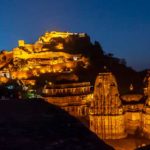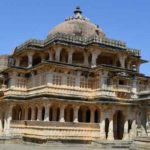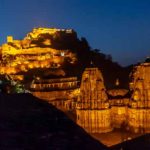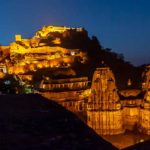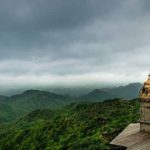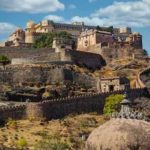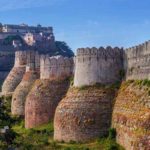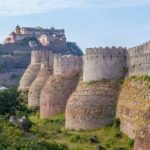Top 8 Monuments to see in Kumbhalgarh is located about 65 km from Udaipur in the Rajsamand district of Rajasthan. The name Kumbhalgarh is derived from the name of the brave and courageous Sisodia Rajput ruler, Rana Kumbha. Kumbhalgarh is famous for the fort and wildlife sanctuary of Kumbhalgarh. The prime tourist attraction is Kumbhalgarh Fort, with its historical significance, great Rajput structures and the third longest wall in the world. Jeep safaris are carried out to explore the local wildlife. In the jungles, tented accommodation is also made available. Diverse flora and fauna have their own charm in the Aravali region.
For its heritage temples and forts, Kumbhalgarh is famously known. It’s a small town nestled in the lap of the Aravalli Hills, and it’s a perfect place to explore when it comes to Udaipur weekend getaways. There are a variety of fine Jain temples with extensively used carvings and murals made from marble. Many festivals are often celebrated where individuals come together to participate and create euphoria of excitement. Kumbhalgarh Fort, built in the 15th century and witnessed a number of wars between the Mauryas and the Mughals, is the town’s main attraction. As it is the birthplace of the great king, Maharana Pratap, the fort has a sentimental significance. There is a series of temples built by the Mauryas, and they provide a clear view of the surrounding area. After the Great Wall of China, the fort was recognised as the second largest wall in the world. As it houses a number of endangered animals such as Nilgai, jackals, sloths, hyenas and many more, Kumbhalgarh sanctuary is a key attraction. Some detailed points are below, read before visiting:-
- It is located in Rajsamund district on the western range of Aravalli Hills and is about 103 km away.
- The best way to reach is by hiring a private cab which would go via NH76 and take around 2 hours.
- The best time to visit the fort is during the winter season, i.e., September to March when the temperature is perfect for walking. Avoid summers because of the scorching heat.
- Timings: 9:00 AM to 5:00 PM; all days
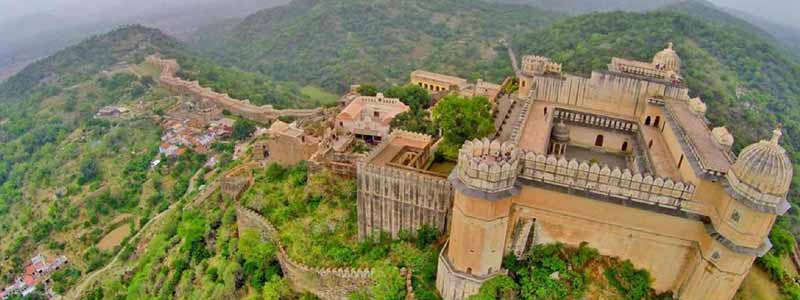
Kumbhalgarh Fort
After Chittorgarh, Kumbhalgarh Fort is Rajasthan’s second most powerful fort. Located 64 km from Udaipur in the district of Rajasmand, Kumbhalgarh Fort is easily accessible from the city of Udaipur. Under the kind of defence of the Aravali ranges, this unconquerable fortress is protected. Kumbhalgarh Fort was constructed in the 15th century by Maharana Rana Kumbha. From the same element, the fort derived its name.
Encircled by thirteen elevated mountain tops, the fort is situated about 1,914 metres above sea level on the topmost ridges. The fort’s fortifications stretch up to a length of 36 kilometres, and this fact has made the fort appear in foreign records. It is claimed to be the world’s second longest wall, the first being “China’s Great Wall”. There are several palaces in the vast complex of the Fort, Temples and gardens make it more sumptuous.
A few kilometres before your journey to Kumbhalgarh Fort, you will find yourself on a zigzag road passing through deep ravines and dense forests. This will take you to the Arait Pol, where the watchtower can be traced, and then Hulla Pol, Hanuman Pol, Ram Pol, Bhairava Pol, Paghra Pol, Top-Khana Pol, and Nimbo Pol will cross your path.
The impregnable Fort boasts seven wide gates, seven folded ramparts with walls toughened by curved bastions and enormous watch towers. The Fort ‘s strong construction and stable base made it unsurpassed to date. The fort’s hefty walls are wide enough to accommodate eight horses side by side. Inside the complex of the Fort, there are no less than 360 temples. Among all of them, a huge Shivalinga (Phallic form) is worth a visit to the Shiva Temple.
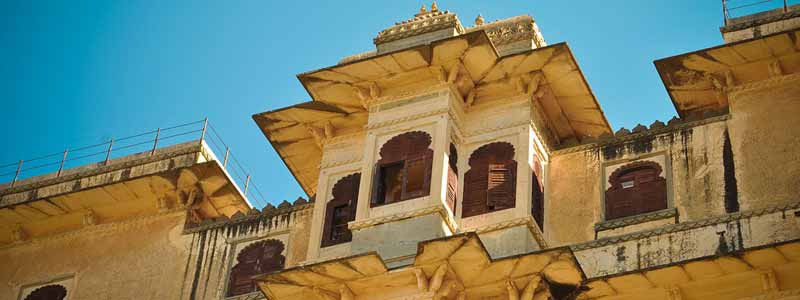
Badal Palace
On the highest peak of Kumbhalgarh Fort, Badal Mahal is situated. The palace is a two-storeyed building divided into the Mardana Mahal and the Zanana Mahal, two interconnected mahals. Zanana Mahal is compact with stone gaols, which made it easier for the royal ladies to see their privacy protected by court proceedings and other key events.
The creative air conditioning system has these chambers, which is an interesting thing to notice. A variety of duct pipes enable the system , which helps cool air to reach the beautiful spaces, further ventilating them from the bottom.
As the palace is situated at the top of the fort, from the top of the hill, it provides an irresistible bird’s eye view of the city. A good number of pastel-colored murals adorn the walls of the Badal Mahal, reflecting the time of the 19th century, which must be a fun experience for all lovers of art. The Badal Mahal rooms are painted on their walls in turquoise, green and white colour schemes. The fort, packed with architectural and natural beauty, provides a great tourist experience for its guests.
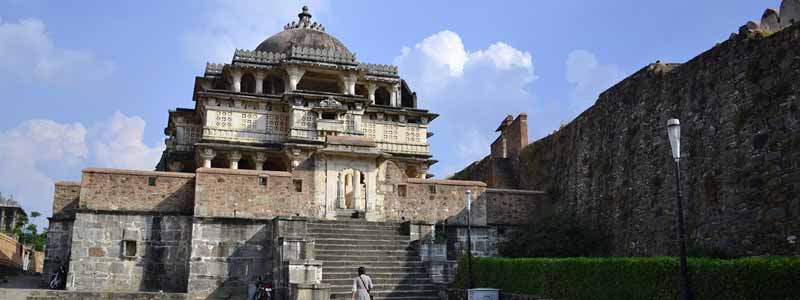
Vedi Temple
Udaipur is a popular city in Rajasthan and is renowned for its ancient and modern structures. One of them is the Vedi Temple, a shrine dedicated to the Vedi Goddess, located in the vicinity of the Fort of Kumbhalgarh in the district of Hanuman Pol of Rajsamand. As one gets to admire the magnificent architecture of the fort and also pay homage to the pilgrim sacrifice site constructed inside the Vedi Temple, the UNESCO world heritage is a great attraction to all On a high platform, the shrine is raised and faces the west.
The temple was made to perform religious rituals practised by the Jain community, as history provides. It stands atop 36 pillars in terms of construction, creating an octagonal shape pattern. The double-storied temple is open to all and envelops you in an envelope of goodness and positivity. This temple, besides. The Archaeological Survey of India recognises, protects and maintains it. There are more temples built at the foothills of the fort.
Kumbhalgarh Wildlife Sanctuary
Khumbhalgarh Wildlife Sanctuary, located in the Rajsamand district of Rajasthan, surrounds the famous Kumbhalgarh Fort. In an area of 610.5 sq km, the sanctuary extends over parts of the districts of Rajsamand, Udaipur and Pali. It also includes the Aravallis-Kumbhalgarh Range, Sadri Range, Desuri Range and the Bokhada Range ‘s four hill and mountain ranges. It is possible to explore Kumbhalgarh Wildlife Sanctuary either by jeep safari, trekking or riding a horse.
Rajasthan’s wildlife sanctuary is known to be the home of a variety of animals, including some endangered species. In the sanctuary, the top predator is a leopard who preys on animals such as sambhar, nilgai, chausingha (the four horned antelope), chinkara, and Indian hare. In Kumbhalgarh Wildlife Sanctuary, there are a large number of birds to be sighted, the grey jungle fowl is the most common one seen here.
Neelkanth Mahadev Temple
The Temple of Neelkanth Mahadeo is a famous Shivji temple located near the Fort of Kumbhalgarh. Founded in 1458 AD, the Shivling, which is made of stone and dedicated to Lord Shiva, is six feet high. The only diet in that region is Shivji. King Rana Kumbha used to worship this god, legends claim. When he offered prayers at the temple, the King was also decapitated by his own son.
Rana Kumbha was so tall that his eyes were on the same level as Shivling when he sat on the floor for the offerings of prayer. To the east of the Vedi shrine, Neelkanth Mahadeo Temple is located. It also has access from all four directions and consists of a sanctum all around and an open pillared mandap.
The inscription on the left column of the western gate tells of Rana Sanga’s renovations.
Mammadev Temple
The Mammadev Temple, built by Rana Kumbha, the ruler of Mewar, in 1460, is located below the Kumbhalgarh Fort. There were originally four slabs in the shrine, and one could see the history of the Kingdom of Mewar engraved on one of the slabs. The inscription traces the history from the reign of Rana Kumbha, a great builder of forts and temples, to the time of Guhil, who was the founder of Mewar. In the Museum of Udaipur, 102 km from Kumbhalgarh, the slabs are now well-persevered. An idol of Lord Kuber, the god of prosperity, and two cenotaphs constructed in memory of Rana Kumbha and Prithviraj Chauhan are also housed in the temple. It is also worth visiting a beautiful reservoir or kund situated near the temple.
Parshuram Temple
Rajasthan’s Parshuram temple is located in the state’s Pali district. Lord Shiva or Mahadev is dedicated to this famous temple. Here, there is an ancient cave that has to be entered by the 500 stairs leading to the cave. The temple also provides an incredible view from the top of the hills of Aravalli and gives you a little trekking experience as you enter the gates of the temple. This place is considered one of the best in the forest of Kumbhalgarh, which is not only a religious site, but also has a beautiful environment for visitors to offer. You will also learn many of the past storeys related to this place from the temple priests, including the different formations known as the Kamdhenu. You will also find Lord Ganesh’s Idol in the temple and nine kunds that never dry out and are considered pious and sacred. From here, you can also visit Kumbhalgarh Fort, which is located close to the temple.
Muchhal Mahavir Temple
The Muchhal Mahavir Jain Temple is located in the Sanctuary of Kumbhalgarh, 5 km from the village of Ghanerao in the Pali district of Rajasthan. The temple dedicated to Mahavira is the only Jain temple where a moustache represents the first Tirthankara Mahavira. Two statues of elephants in guarding postures at the gateway comprise the temple. The tribe of Garasia lives in a village that is located near this temple. Among all the Indian tribes, the dress of these tribals is known as the most colourful. They perform a great group dance on the temple platform two or three days after the festival of Holi. A fair is held here every year on the thirteenth day of the month of Chaitra.

